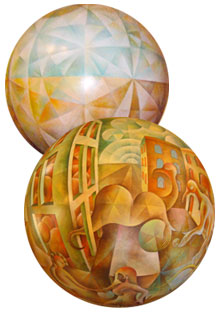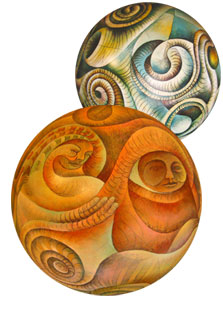

The question is; should an artist ever take older works and go back into them years later? I guess my feeling is, sometimes it seems like a good idea. Sometimes after an idea circles in your mind for a number of years you understand more the second time around. I haven’t done this very often but I have done it a few times. I guess if I feel I can improve on them, why not leave behind the best work I can. The bad side of this is that you lose the history of the artist. I guess I think I am leaving enough of that behind anyway. A few of the spheres I have reworked including HARMONIOUS WORLD and HUMANS FROM THE UNIVERSE which are shown below. Both of these had nice substructures growing from three dimensional geometries but I felt they could have more levels of interest to them. I transformed some of the patterns into a designed realism of animals and human forms. I like them much better now but the question is, should an artist do such a thing? Do you think they are improved or should I have left them alone? You are probably saying, too late now.
Comments 5
Richard, that’s the kind of question that computers and quantum theory have made obsolete, don’t you think? The question now is, how many of the infinite number of possible ways this thing could look should I actually make manifest? In the case of a reworked piece, it seems your answer would be “two.” The only sad part is that we don’t still have them both here in “meatspace.” Oh well.
I do feel that going back to earlier works is an absolute necessity. You are not only go back to a piece of work, but in time in a way by recollecting a part of your own history and manipulating the ‘final’ piece. Discovering inventions of techniques based on other artists, especially masters is wise. Your work is truly inspiring.
Author
thank you………..Dick Termes
Hi Dick… for an artisitic comparison, consider the opera composer Giuseppe Verdi who several times in his career re-worked earlier works, often turning what was an acceptably decent opera into absolute an masterpiece (Simon Boccanegra or Don Carlo being two such examples). In each instance, the years of additional artistic maturity yielded added layers of richness for the listener (and posterity). Perhaps what’s unique is that both the original and later iterations remain available for appreciation. With Termespheres, does re-working an older sphere translate to painting over, or adding onto, the original surface (versus painting a fresh iteration on a new sphere)? That, of course, makes for a far harder decision… and unfortunately no clear-cut answer.
thank your